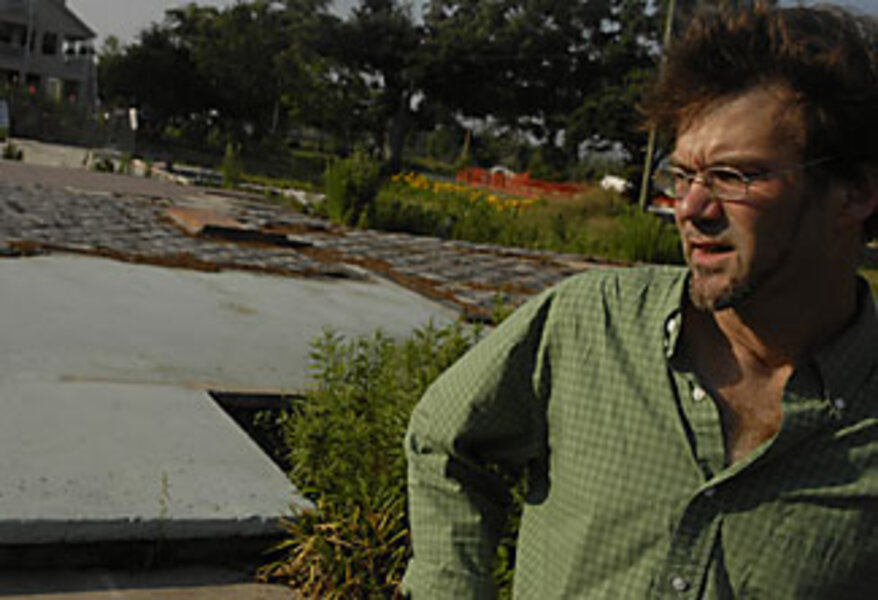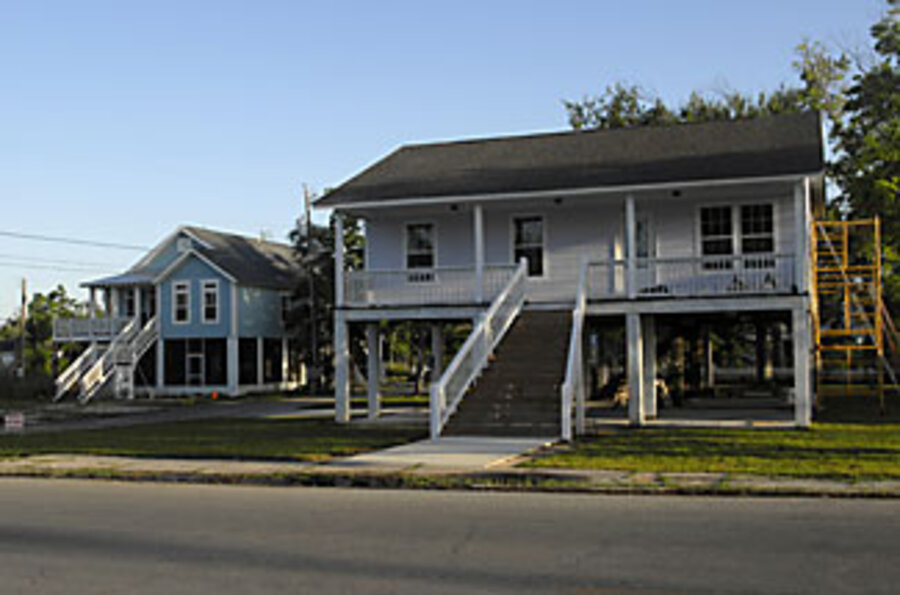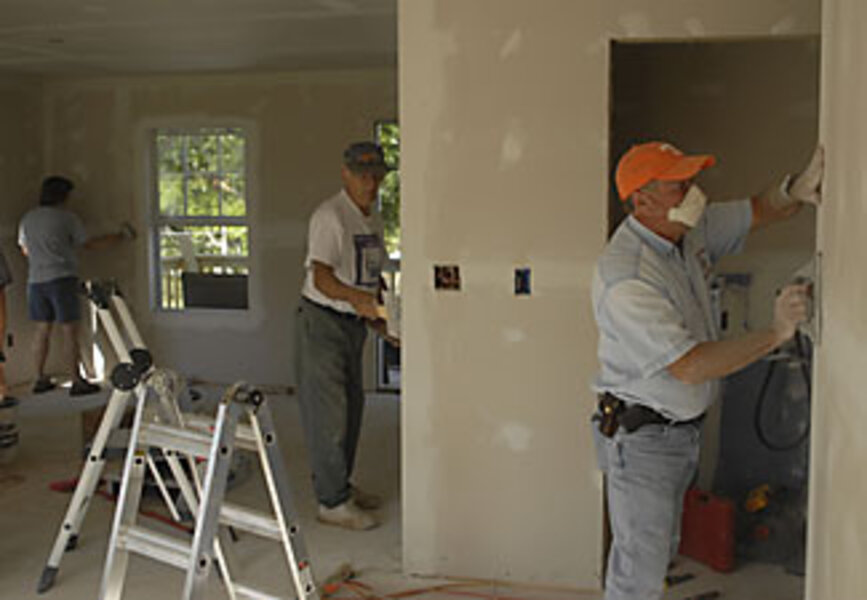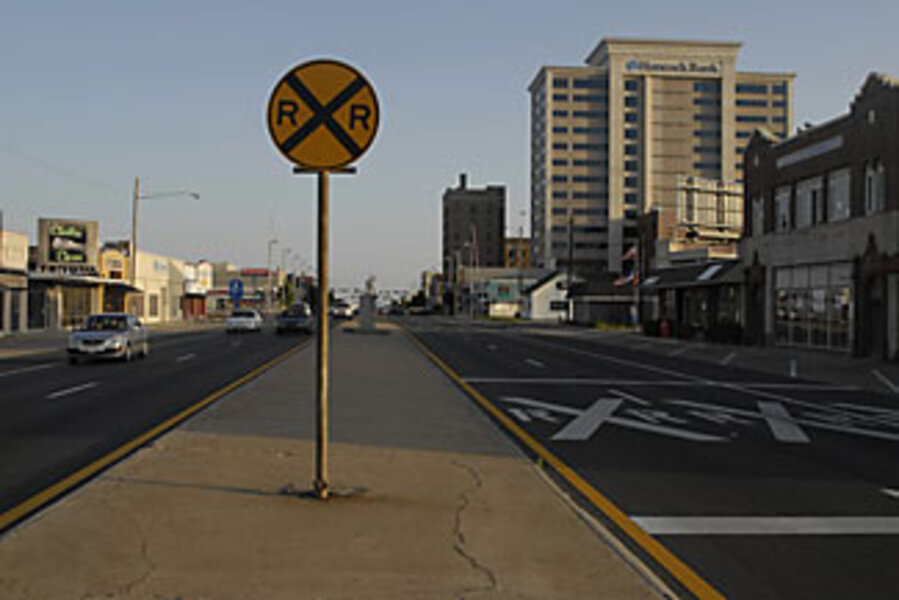The new Gulf: Safe enough?
Loading...
| Bay St. Louis, Miss.
Crews with trucks and bulldozers are laying pipe and asphalt along Main Street of this Gulf Coast town, as customers at the Mockingbird Cafe, seemingly oblivious to the din, sip cappuccinos. Traffic now clogs inland Route 90 on most mornings, and the local building inspector has recently complained of being "swamped" with work.
Well into the third year since hurricane Katrina leveled nearly all the shoreline mansions and tore beachfront shops to pieces, Bay St. Louis is, for all intents and purposes, a boom town, along with much of surrounding Hancock County.
"The country is [about] in recession, but we're not seeing anything like that here – quite the opposite," says Jeffrey Reed, city council president.
Stoking this boom – and similar ones in Mississippi's two other Katrina-walloped counties – is $38 billion in federal aid and private insurance money that has been spread across this coast like a salve. It's a lot of money – as much as $100,000 for every resident in the three counties – intended to help this long, thin sliver of warm sand and live oaks recover from one of the worst natural disasters in American history.
As much as Americans are willing to invest taxpayer dollars to make Katrina country whole, many also want assurances that what rises from the cataclysm is sensible – communities rebuilt to take another direct hit from a Category 3 storm without devastating loss of life or property. Most observers agree that what's going up now is much improved over what was on the ground the August morning the hurricane rushed ashore with its 120-mile-per-hour winds and 27-foot-high storm surge. Many Gulf communities have adopted better building codes, including strapping all new houses to the ground by their studs. Some have pledged to funnel new construction to higher ground, resisting the temptation to let businesses and homes sprawl in low-lying areas where the surge caused the most destruction.
But time is of the essence, as new and returning residents have urgent need of places to live and work, and expediency is not always the friend of prudence. Some who are watching the rebuilding boom say the Mississippi coast will not be safe enough because officials are not forcing development to withdraw from places slammed by Katrina and many home-owners are rebuilding in low-lying areas rather than accepting federal government buyouts. Plans for gigantic new steel-and-concrete storm barriers at key spots along the coast do not allay their concerns.
"The most accurate answer is that we're only partly building back the right way," says Jeff Bounds, an MIT-trained planning consultant to the cities of Gulfport and Pass Christian. "The culture of the South is very big on independence and not liking handouts ... but my view is that if federal taxpayers knew in detail a lot of what was going on, they'd be very, very unhappy."
Of course, what constitutes "safe" rebuilding is a matter of much debate, especially as the extra costs associated with some of the precautions begin to mount, along with the risk that poorer families will be driven out altogether. Often, engineers have one view and local politicians another. Or hydrologists see a pressing need but the business community sees another. The result is a push and pull, a stretch and twist of the new rules.
•Bay St. Louis is appealing to the Federal Emergency Management Agency to reconsider how high off the ground new buildings must be to qualify for federal flood insurance. In certain low-lying places, buildings need to sit on stilts 18 feet high, FEMA has ruled. The town counters that the requirement puts the structures at risk of wind damage and wants a lower requirement.
Some say the town's action is rooted more in nostalgia than in science. "People [are] upset because the elevations mean the town wouldn't look the same, and it was a beautiful town, Bay St. Louis," says Steve Champlin, Mississippi's flood-mapping coordinator, in Jackson.
•The nation's first regional buyout program for storm-struck properties did not include North Central Pass, a poor neighborhood in Pass Christian situated in a low bowl in the sand. Those residents would have been likely to take the buyouts – perhaps the only way they could afford to move to higher ground, say critics. So far, only tiny Pecan, Miss., with a total of 18 properties, most owned by one family, has taken up the government's offer.
The US Army Corps of Engineers denies charges that the program is aimed at wealthier people. "The [buyout] is not a welfare program for the rich," says Susan Rees, director of the Corps' Mississippi Coastal Improvement Program. "We're trying to assist the people ... who really don't have the wherewithal to just pick up and move somewhere else."
•Proposals to use federal Community Development Block Grants to build two new yacht marinas near Bay St. Louis and Waveland, Miss., are popular, but critics say they would put million-dollar boats and new development right on an unprotected shoreline.
•In April, Bay St. Louis heard a request to allow people building in the area to hire so-called third-party inspectors. Advocates say the policy change would alleviate a shortage of building inspectors and give "more personalized" service. Critics say it's not clear whether the freelance inspectors would represent the interests of the public or the homeowners who hire them.
•Differences in the topographical flood maps published two months after Katrina and the revised maps FEMA released in November have raised concerns that mapmakers were subjected to pressure by wealthy stakeholders along the coast. The result "appears to be some maps being redrawn by hand" perhaps to appease specific landowners, says Mr. Bounds. State officials say the changes are a result of complex surge-prediction algorithms that factor in more than raw elevation. "It's pure science," says Mr. Champlin, the state mapmaker.
Yet building inconsistencies are apparent during a drive along the coast. On streets that Katrina demolished in equal measure, new buildings are on stilts from four to 18 feet tall – sometimes higher. To rebuild a home in the lowest areas of Pass Christian, the first-floor joists must be 26 feet off the ground.
"One guy is building 12 feet in the air because he's freaked out. The next guy is building at eight feet because that's the new flood regs," says Bounds. "The next guy is building at four feet because he's grandfathered in [to the pre-Katrina code requirements], and the next guy is building right on the beach because he knew somebody at city hall and was able to get away with it."
State officials say Mississippi has done a good job overall of balancing needs of people and businesses with mandates for stronger building materials and height requirements for homes in flood zones.
"A comprehensive recovery program has to include the whole package: direct assistance, help to build more homes, partnering with people who can build on a large scale, and economic ... development," says Lee Youngblood, spokesman for the Mississippi Development Authority, the purse-string holder for federal recovery grants. "We're trying to make sure we're good stewards of the money we're giving, trying to make sure we get as many of our recovery needs met ... not just in terms of housing but long-term infrastructure and things we're going to need to sustain jobs."
There's a reason economic concerns compete with safety. The recovery has been tenuous, "much, much slower than we all thought it would be," says Bay St. Louis historian Charles Gray. Thousands of Gulf Coast residents have permanently relocated. Condo construction has leveled off as part of the national housing slowdown, and communities like Bay St. Louis are desperate for tax and fee revenues to repay storm-related loans.
In short, the boom is a fragile one, susceptible to the vagaries of government decisionmakers and the whims of developers. The coming hurricane season, too, could affect how quickly people press ahead with rebuilding.
"All we can do is put one foot in front of another," says John Harral, a business lawyer in Gulfport. "It is every day a struggle with what is it going to look like, what can we do, how restrictive can the laws and regs be, and how restrictive should they be?"
Those who question officials' priorities cite a climate of secrecy in state agencies that makes it difficult, they say, to get copies of revised flood-zone maps or accurate information about how large new roads and bridges will be leading to the coast. As a result, activists see certain state decisions, such as one to use $600 million in federal Housing and Urban Development (HUD) grants to retrofit the port at Gulfport instead of to build safe and affordable housing, as proof that business interests have the ear of the governor and the legislature and that safety is being played down.
"We're not showing the sense of collaboration you'd like to see between nonprofits and industry and different branches of government," says Marianne Hill, chief economist at the state College Board in Jackson, Miss. "It's difficult to forge a new institutional framework."
A problem for the Gulf Coast's recovery is the absence of a federal rebuilding czar to oversee the spending of tax dollars, say critics. Key US agencies working hardest on Gulf recovery – the Army Corps, FEMA, and HUD – are often at cross-purposes, they note. HUD promotes housing and industry, while the Army Corps and FEMA are trying to get the state and municipalities to carefully channel redevelopment. The US Senate last week signaled a greater willingness in Washington to rein in the national flood insurance program, voting 92 to 6 to limit coverage of businesses and second homes that flood repeatedly and to let FEMA raise insurance rates by as much as 15 percent a year.
For many trying to hold onto their spit of Mississippi sand, government efforts seem disjointed and careless. The government is "throwing money left and right, but very little is directly helping people," says Leo Poole, a retiree who's struggled to keep his Bay St. Louis house.
On the other hand, some economists say the recovery has been managed with too heavy a hand. Instead of the government spending millions of dollars on trailers, they say, a large direct-aid check to storm victims would have precipitated a natural disbursement of people and property, and would have allowed those in risky areas to more easily make a decision to move elsewhere. Instead, 8,000 Mississippi families still live in FEMA trailers in neighborhoods that Katrina destroyed.
"I understand why people think there's a conspiracy, because it's almost as if policy is aligned against the poorest, hardest-hit communities," says Emily Chamlee-Wright, an economist at Beloit College in Wisconsin, who has studied the Gulf rebuilding process. "A lot of times the attempt to protect people becomes the wrong policy. The heavier hand you have in the planning process and the more overreaching it is, the more trouble there's going to be down the line."
The irony is that the slow pace of rebuilding – everyone's top complaint – may be the greatest ally to a safer coast, forcing meticulous consideration of even mundane plans and projects, and plenty of time for everyone to talk the issues out at places like the Mockingbird Cafe in Bay St. Louis. Government officials such as Mr. Youngblood note that the lag time in the recovery is due in large part to the strict rebuilding rules, whether it's federal fill permits or expensive storm-certification requirements for new home construction, all of which in the long run will ensure a more storm-proof coast.
As seen in the little boom town of Bay St. Louis, shovels are now hitting the dirt in earnest – making this spring a crucial window for determining how well the coast, and US taxpayers, will weather any future big storm.
Tellingly, says Mr. Harral, the Gulfport business lawyer, vital water and sewer pipes have been delivered to municipalities but are just now being installed under roads like Beach Boulevard in Bay St. Louis.
"Nearing the third anniversary of the storm, that is a ... good illustration [of the recovery as a whole]: that it's all still on the ground, lying where it's going to be, but it hasn't been put in the ground yet," says Harral.











